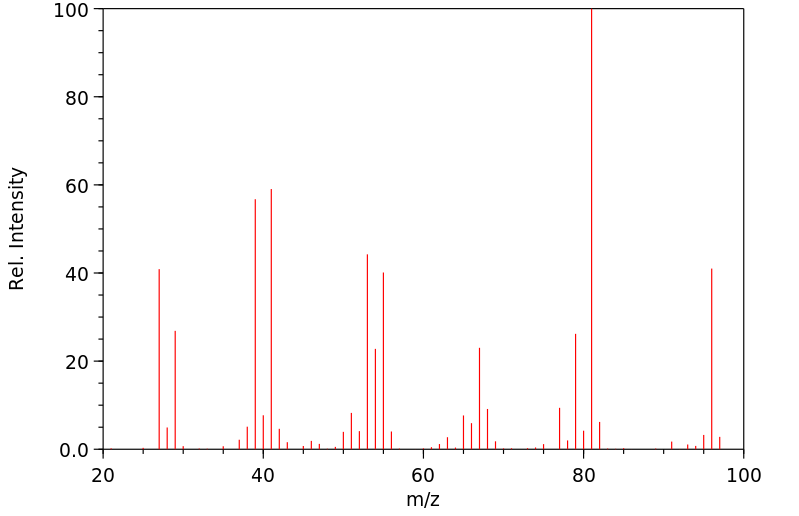hepta-2,5-diene | 39619-60-8
中文名称
——
中文别名
——
英文名称
hepta-2,5-diene
英文别名
hepta-trans-2-trans-5-diene;trans,trans-hepta-2,5-diene;(E,E)-hepta-2,5-diene;(E,E)-2,5-heptadiene;2,5-heptadiene;hepta-2t,5t-diene;2,5-Heptadiene, (E,E)-;(2E,5E)-hepta-2,5-diene
CAS
39619-60-8
化学式
C7H12
mdl
——
分子量
96.1723
InChiKey
JAGYXYUAYDLKNO-GGWOSOGESA-N
BEILSTEIN
——
EINECS
——
-
物化性质
-
计算性质
-
ADMET
-
安全信息
-
SDS
-
制备方法与用途
-
上下游信息
-
文献信息
-
表征谱图
-
同类化合物
-
相关功能分类
-
相关结构分类
物化性质
-
保留指数:708.3;716.4;705.1
计算性质
-
辛醇/水分配系数(LogP):2.6
-
重原子数:7
-
可旋转键数:2
-
环数:0.0
-
sp3杂化的碳原子比例:0.43
-
拓扑面积:0
-
氢给体数:0
-
氢受体数:0
上下游信息
反应信息
-
作为反应物:描述:参考文献:名称:FRANKEL, E. N.;GARWOOD, R. F.;VINSON, J. R.;WEEDON, B. C. L., J. CHEM. SOC. PERKIN TRANS., 1982, N 11, 2707-2713摘要:DOI:
-
作为产物:描述:(E)-hept-5-en-2-yn-1-ol 在 吡啶 、 lithium aluminium tetrahydride 、 三溴化磷 作用下, 以 四氢呋喃 、 乙醚 为溶剂, 反应 25.0h, 生成 hepta-2,5-diene参考文献:名称:Chin, Slow Khim; Golding, Bernard T.; Pierpoint, Colin, Journal of Chemical Research, Miniprint, 1985, # 3, p. 946 - 953摘要:DOI:
文献信息
-
Reactions of Carbocations with Unsaturated Hydrocarbons: Electrophilic Alkylation or Hydride Abstraction?作者:Herbert Mayr、Gabriele Lang、Armin R. OfialDOI:10.1021/ja0121538日期:2002.4.1published empirical electrophilicity parameters E of the benzhydrylium ions. Therefore, the linear free energy relationship log k(20 degrees C) = s(E + N) could be employed to characterize the hydride reactivities of the hydrocarbons by the nucleophilicity parameters N and s. The similarity of the slopes s for hydride donors and pi-nucleophiles allows a direct comparison of the reactivities of these different
-
Pheromone 69.<sup>1</sup>Stereoselektive Synthesen nichtkonjugierter bisolefinischer Lepidopteren-Pheromone und Strukturanaloger作者:Hans Jürgen Bestmann、Thomas Zeibig、Otto VostrowskyDOI:10.1055/s-1990-27089日期:——Pheromones 69.1 Stereoselective Syntheses of Nonconjugated Bisolefinic Lepidoptera Pheromones and Structural Analogs Coupling reactions of lithium compounds, (Z)-carbonyl olefination of phosphonium ylides and "crossed" Wittig olefination of bisylides are the key reaction steps in the synthesis principle for nonconjugated, bisolefinic Lepidoptera pheromones and structural analogs. Double unsaturated (E,Z)- and (E,E)-1-vinyl halides are converted into the corresponding (E,Z)- and (E,E)-1-vinyl lithium compounds and coupled selectively to (E,Z)- and (E,E)-alkadienols, alkadienals and alkadienyl acetates with different carbon chain length, geometry and relative positions of double bonds. "Crossed" Wittig reactions of 1,Ï-alkylidene bisylides with two different alkanals gives rise to the formation of corresponding (Z,Z)-dienic sex attractants and derivatives. A monounsaturated (E)-1-vinyl iodide is the synthon for the preparation of an (E)-alkenyl bromide which is converted to an (E)-alkenyl phosphonium salt and (Z)-selectively olefinated to (Z,E)-isomers of moth sex pheromones.信息素 69.1 非共轭双烯类鳞翅目昆虫信息素及其结构类似物的立体选择性合成 锂化合物的偶联反应、磷烷阳离子盐的(Z)-羰基烯化以及双阳离子的“交叉”维蒂格烯化是合成非共轭双烯类鳞翅目昆虫信息素及其结构类似物的关键反应步骤。双不饱和的(E,Z)-和(E,E)-1-烯基卤化物转化为相应的(E,Z)-和(E,E)-1-烯基锂化合物,然后选择性偶联生成不同碳链长度、几何结构及双键相对位置的(E,Z)-和(E,E)-烷二醇、烷二醛及烷二烯基醋酸酯。1,ω-烷基烯基双阳离子与两种不同烷基醛的“交叉”维蒂格反应生成相应的(Z,Z)-二烯性别吸引剂及其衍生物。单不饱和的(E)-1-烯基碘化物是制备(E)-烯基溴化物的合成子,后者转化为(E)-烯基磷烷盐,并选择性地烯化为蛾类性别信息素的(Z,E)-异构体。
-
Complexations of 1,4-dienes to rhodium(I) pentane-2,4-dionates; thermal rearrangements of the complexes作者:Rajindra Aneja、Bernard T. Golding、Colin PierpointDOI:10.1039/dt9840000219日期:——bis(ethylene)(pentane-2,4-dionato)rhodium(I) each dienol rearranged to give an enone as, the main product [e.g.(E,E)-hepta-2,5-dien-4-ol →(E)-hept-2-en-4-one (85%)]. Their acetates rearranged to isomeric conjugated dienes [e.g.(Z,Z)-4-acetoxyhepta-2,5-diene →(3E,5Z)-2-acetoxyhepta-3,5-diene]. The hepta-2,5-dienes were recovered unchanged. The mechanisms of the rearrangements observed are explained in terms of作为包含“跳过的”二烯片段(–CH CHCH 2 CH CH–),一系列七,2,5-二烯,七,2,5-二烯-4-醇和七,2的天然产物的模型,已经制备了5-二烯-4-醇乙酸酯。这些二烯中的一些与双(乙烯)(戊烷-2,4-去离子)铑(I)或双(乙烯)(1,1,1,5,5,5-六氟戊烷-2,4-去离子)反应铑(I)生成1:1配合物,例如[((E,E)-庚-2,5-二烯](1,1,1,5,5,5-六氟戊烷-2,4-去离子基)铑(我)。其他二烯,例如(Z,Z)-庚-2,5-二烯形成2∶1的络合物,其中对于每个二烯分子,一个双键与铑配位,而另一个不配位。(Z,Z)-二烯不形成1:1配合物,因为在这种配合物中每个双键的末端取代基之间将存在严重的空间相互作用。对于二烯醇和某些烯丙醇(例如丙-2-烯-1-醇)的配合物,已获得证据表明,每个OH和其最近的戊烷-2,4- CO之间存在稳定的分子内氢键。长老。当在苯中与5摩尔%的双(乙烯)(戊烷-2
-
Frankel, Edwin N.; Garwood, Robert F.; Vinson, John R., Journal of the Chemical Society. Perkin transactions I, 1982, # 11, p. 2707 - 2714作者:Frankel, Edwin N.、Garwood, Robert F.、Vinson, John R.、Weedon, Basil C. L.DOI:——日期:——
-
Solution-phase photodecarbonylation of the bicyclo[3.1.0]hexan-3-one system作者:Robert S. Cooke、Gregory D. LyonDOI:10.1021/ja00414a046日期:1981.12
表征谱图
-
氢谱1HNMR
-
质谱MS
-
碳谱13CNMR
-
红外IR
-
拉曼Raman
-
峰位数据
-
峰位匹配
-
表征信息
同类化合物
高密聚乙烯
香叶醇
顺式3-甲基-2-己烯
顺式-5-癸烯
顺式-5-甲基-2-己烯
顺式-5-庚烯-1-炔
顺式-4-癸烷
顺式-4-甲基-2-戊烯
顺式-4-甲基-2-戊烯
顺式-3-癸烯
顺式-3-甲基-3-己烯
顺式-3-甲基-2-庚烯
顺式-3-戊烯-1-炔
顺式-3,4-二甲基-3-己烯
顺式-3,4-二甲基-2-戊烯
顺式-3,4-二甲基-2-戊烯
顺式-2-甲基-3-己烯
顺式-2-壬烯
顺式-2-丁烯-D1
顺式-1.1.1-三甲基-2-丁烯
顺式-1-甲基-2-环丙基乙烯
顺式-1-甲基-2-乙烯基环戊烷
顺式-1-环戊基-1-辛烯
顺式-1-氘代-3-甲基-1-丁烯
顺式-(9ci)-2,3,3a,7a-四氢-4-(1-甲基乙基)-1H-茚
顺式-(2-丁烯基)环丙烷
顺式,顺式-2,4-己二烯
顺-环辛烯
顺-9-二十一碳烯
顺-6-十三碳烯
顺-5-甲基-1,3,6-庚三烯
顺-4-辛烯
顺-4-壬烯
顺-3-辛烯
顺-3-甲基-2-戊烯
顺-3-壬烯
顺-3-十三碳烯
顺-2-辛烯
顺-2-癸烯
顺-2-戊烯
顺-2-庚烯
顺-2-己烯
顺-2-丁烯
顺-2,2-二甲基-3-己烯
顺-1,3-戊二烯
顺,顺-1,9-环十六烷二烯
顺,顺,顺-环癸-1,3,5-三烯
间戊二烯
间二(4-吡啶基)苯
镁,二-2-丁烯基-







